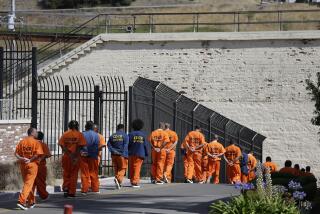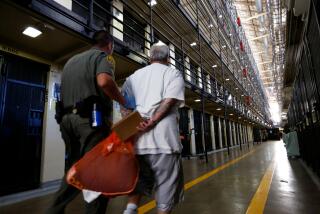Catch a cold, go to prison: The recidivism debate

One bit of popular lore that Californians often hear regarding our criminal justice system is that the state has an extraordinarily high rate of recidivism — the nation’s highest, at somewhere between 65% and 75%. That figure is cited in legislative hearings, community meetings and news conferences, and in fact was repeated last week by Atty. Gen. Kamala Harris as she unveiled a new division in her office to deal with the problem.
Harris, understandably, was using the figures and the jargony word “recidivism” as rhetorical shorthand; she noted that the state’s 58 counties have a hard time comparing data and learning from one another’s successes and failures, and she said her office would now provide some needed uniformity and a platform for sharing data.
But any attempt to drive down the rate at which former offenders get back into trouble has to steer clear of that kind of shorthand. Criminal justice officials from the attorney general to judges, prosecutors to police would be wise to come up with an entirely new lexicon to describe just what it is they are trying to track and correct.
That’s because “recidivism” has so many different meanings that, without meticulous explanation, it has no meaning at all, leading people to bandy about numbers and concepts that are misleading or downright false, and to create programs that cost money but don’t necessarily solve any problems — or, at least, that fail to solve the problems they purport to address. Clearer language is needed to produce clearer results.
In common parlance the word is generally taken as the criminal justice analog of the medical term “relapse.” A person who has cancer and is treated, for example, but is later diagnosed again with the disease is said to have relapsed, and likewise a criminal offender who commits another crime is said to have recidivated.
But what if the cancer patient catches a cold? He’s sick again, but has he relapsed?
Of course not. It would be both alarming and comical to insist that every cancer patient who ever again has to call in sick or take an aspirin has relapsed, if the word is to have any useful meaning. Using the same term to describe a wide variety of conditions that require different responses — or sometimes no response at all — obviously would be useless to the physician and anyone else who is trying to measure how well any given treatment works and whether it’s worth the cost.
So does California define recidivism as a kind of relapse? Sometimes. Our chief anti-recidivism law, known popularly as “three strikes,” applies only to those instances in which a person convicted of a serious or violent felony is later convicted of another serious or violent felony. But other statutes and guidelines, used for other purposes — such as declaring our recidivism rate the nation’s highest — apply to a felon or misdemeanant who is later convicted of any kind of crime, or not convicted but merely arrested, or not even arrested but tests positive for drug use, or not even that but is cited by a parole agent or probation officer for failing to show up on time for an appointment.
Is failing a drug test or missing an appointment like a full-scale relapse, or is it the parolee’s equivalent of catching a cold? In defense of her office’s fairly strict definition of recidivism, Los Angeles County Dist. Atty. Jackie Lacey argues that she needs to know whether a person released from jail or prison is straying from the straight-and-narrow, and that may well be useful information that helps shape an effective response. But the question is not whether a dirty drug test should or should not be noted or punished but whether it’s the equivalent of, and should be measured the same as, a conviction for a new felony.
It is in part the high rate of return to incarceration due to so-called technical violations that makes California so different from the rest of the nation and makes our recidivism rate seem so high. Returns to prison are a useful measure for officials who need to know how many inmates are likely coming back, and when, but not so useful for gauging how much risk a former inmate poses to his neighborhood or how likely he is to commit another felony.
When technical parole violations are stripped out and the measure of recidivism is a new crime with a new arrest and a new conviction, the way we calculate the number for three-strikes offenses, California’s recidivism rate is closer to 50% — not good, but just about the same as most other states. Without an explanation of that distinction between the two criteria for measuring, the assertion that California has the nation’s worse recidivism rate is false, and any spending or programming decisions based on that assertion are suspect.
What lawmakers and the public really need to know about the criminal justice system is what works and what doesn’t, and for whom. Applying a binary definition of recidivism — did you get into some kind of trouble again or didn’t you — is like asking whether the cancer patient got sick again. Who cares if he got a cold; that tells us nothing about whether his treatment worked.
The attorney general and the counties would be wise to focus less on recidivism rates and more on an inmate’s reentry into society after incarceration, with gradations of success, paired perhaps with different levels of official response. That kind of calculation may be more complex, but in the end it will guide officials and the public toward solutions that work.
More to Read
A cure for the common opinion
Get thought-provoking perspectives with our weekly newsletter.
You may occasionally receive promotional content from the Los Angeles Times.






